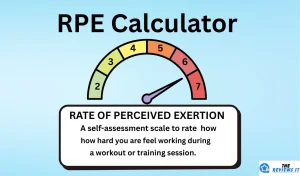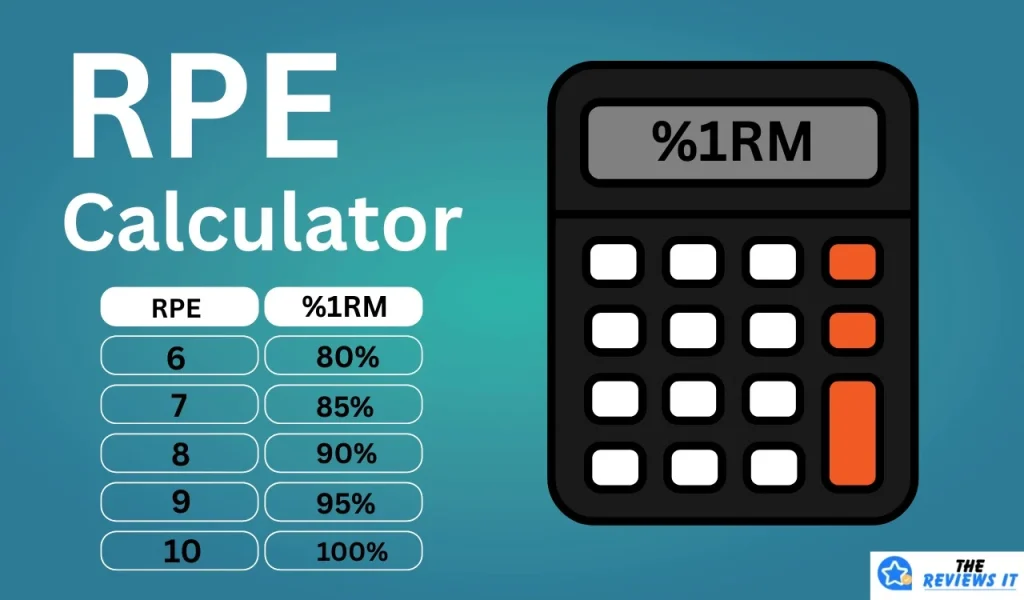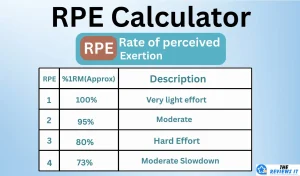Results:
Estimated 1RM:
Working out isn’t just about showing up, it’s about training at the right intensity. If you push too hard, you could get injured. You should go too light, and your progress will be slow.
That’s where the RPE Calculator helps. RPE, or Rate of Perceived Exertion, is an easy way to measure how hard a workout feels. When you combine this scale with tools like a one-rep max (1RM) RPE chart calculator, you can adjust your training based on how your body feels that day.
The RPE load calculator quickly turns your effort level into a percentage of your 1RM, so you can lift, run, or train at the right intensity every time. If you are doing open powerlifting, running, or recovery, rpe powerlifting calculator keeps your workouts accurate and flexible.
Table of Contents
ToggleWhat Is RPE?
Rate of Perceived Exertion (RPE) is a self-assessment scale that rates how hard you feel you’re working during a set, workout, or training session. It’s based on your breathing, muscle fatigue, and overall exertion, not just the weight on the bar or your stopwatch time.
The most common RPE scale runs from 1 to 10:
- 1-3: Very light effort (easy warm-up pace, could maintain for a long time)
- 4-6: Moderate effort (breathing faster but still comfortable)
- 7-8: Hard effort (challenging, talking in short sentences)
- 9: Very hard effort (only one rep or small push left)
- 10: Maximum effort (cannot do more)

Why Use RPE Instead Of Fixed Percentages?
Traditional training often uses fixed percentages of your 1RM to set workout weights. This works, but it doesn’t adjust for daily changes in your strength or stamina caused by:
- Fatigue from previous workouts
- Lack of sleep
- Poor nutrition or hydration
- Stress levels
- Injury recovery stage
This one rep max calculator RPE adjusts its functions based on how you feel today. For example, if you planned to lift 80% of your 1RM but feel unusually strong, you can increase the load to reach an RPE of 8.
On the other hand, if you’re feeling tired, the RPE max calculator helps you reduce the load while still maintaining the right training intensity.
An RPE calculator helps you train smarter, and tools like NippyBox can securely store your logs for easy tracking.
Explore NippyBox – Most Secure Cloud Sharing And Storage Platform
Benefits Of RPE-Based Training:
- More personalized workouts
- Reduced injury risk
- Flexible for changing conditions
- Works across strength, endurance, and rehab programs
How Does The RPE Calculator Work?
The RPE to Percentage Calculator connects how hard you feel you’re working with your actual performance level.
Steps To Use:
- Determine Your RPE: After a set or during an exercise, assess how hard it felt on a 1-10 scale.
- Input RPE And 1RM: Enter your perceived effort and your known or estimated one-rep max into the RPE percentage calculator.
- Get %1RM And Load: The calculator converts your RPE into an approximate percentage of your 1RM and suggests the weight or pace for that effort.
RPE To %1RM Conversion Chart
| RPE | %1RM (Approx.) | Reps in Reserve (RIR) | Description |
| 10 | 100% | 0 | Max effort, no reps left |
| 9.5 | 98% | 0-1 | Almost max effort |
| 9 | 96% | 1 | Very heavy |
| 8.5 | 94% | 1-2 | Heavy |
| 8 | 92% | 2 | Challenging |
| 7.5 | 90% | 2-3 | Moderate-heavy |
| 7 | 88% | 3 | Solid working weight |
| 6.5 | 86% | 3-4 | Moderate |
| 6 | 85% | 4 | Comfortable pace |
| 5 and below | <80% | 5+ | Very light work |
Using RPE For Strength Training
In strength training, RPE (Rate of Perceived Exertion) is closely connected to the concept of Reps in Reserve (RIR), which simply means how many more reps you could complete before reaching failure. This makes it an easy, practical way to gauge workout intensity.
For example:
- RPE 8 = about 2 reps left in the tank
- RPE 9 = about 1 rep left
- RPE 10 = no reps left, maximum effort
Here’s what a bench press workout might look like when using RPE:
- Warm-up: 2–3 light sets at RPE 4–5 to prepare the muscles and joints
- Working sets: 4×6 at RPE 7 (around 88% of your 1RM if using a bench RPE estimate calculator)
- Accessory lifts: 3×10 at RPE 6 for added volume without excessive fatigue
This approach helps you train hard enough to build strength while keeping recovery in check. By matching your effort to how you feel that day, you avoid pushing too far when you’re fatigued and still make steady progress when you’re feeling strong.
Over time, using a 1RM calculator RPE can lead to more consistent gains and less risk of burnout or injury.
You can also use productivity and tracking apps like ATT Shift to organize your training schedules and log your RPE scores for better consistency.
Using RPE For Endurance Training
For runners, cyclists, and rowers, the bench RPE calculator spreadsheet running RPE calculator is a reliable training guide, especially when heart rate monitors or GPS watches aren’t available, or when factors like heat and surface conditions affect performance.
The RPE endurance scale helps match effort to training goals: RPE 2–3 is an easy recovery pace, RPE 4–5 builds aerobic endurance, RPE 6–7 is ideal for tempo or threshold training, RPE 8–9 suits intervals or sprints, and RPE 10 is an all-out effort.
A sample RPE-based running plan might include 45 minutes at RPE 4–5 on Monday, six 400m intervals at RPE 8 on Wednesday, and a 30-minute recovery jog at RPE 3 on Friday, balancing intensity and recovery for steady progress.
Using RPE For Rehab And Recovery
In physical therapy and post-injury recovery, the RPE scale calculator plays a crucial role in helping patients manage their exercise intensity safely.
By paying attention to how hard they feel they’re working, patients can exercise enough to heal and get stronger without hurting themselves or stressing injured areas with rpe rep calculator.
Therapists often recommend performing exercises at a moderate effort level, typically around RPE 3 to 4, which encourages movement and muscle activation while protecting the healing area.
This personalized approach supports gradual progress, reduces the risk of setbacks, and enhances overall recovery outcomes.
Common Mistakes While Using RPE
Even though RPE is helpful, people often make some common mistakes when using it. Here are some common mistakes:
Overestimating Effort: Beginners often think an RPE 7 feels like a 9, which can lead to training harder than intended and cause fatigue too early.
Not adjusting For Fatigue: RPE should reflect how the exercise feels today. Stress, poor sleep, or recovery from a tough session can make the same workout feel harder, and your numbers should adjust accordingly.
Ignoring Other Metrics: RPE works best alongside heart rate, pace, rest times, and recovery markers. Relying only on RPE can limit accuracy and slow progress.
Many tools can track your form for more accurate RPE, and if you log scores in apps, remember to follow digital safety practices.
Also Read Zryly.com Internet – Trusted Resources For Cyber Protection
Tips For Getting The Most Out Of The RPE Calculator
If you want a better experience with the 1 RPE calculator, you should consider these tips :
- Log your RPE after each workout to track trends.
- Learn how RPE feels by testing your limits occasionally.
- Use the calculator consistently to improve accuracy over time.
- Combine RPE with structured training blocks for the best results.
Reddit Review – RPE Training Calculator That Makes Lifting Easier
A popular RPE Training Calculator from Reddit is making lifting easier and more accurate. Instead of manually figuring out your potential max and cross-checking RPE calculator charts, this Excel-based tool does it instantly.
You just enter up to four of your best sets, and it calculates your estimated max along with a full RPE chart. Percentages can be adjusted for different training styles, and it works in both Excel and Google Sheets.
Lifters say it saves time, removes guesswork, and makes programming more straightforward.
| Pros | Cons |
|
|
|
|
Conclusion
The RPE Calculator turns your feeling of effort into clear numbers that make training easier to plan. It helps you adjust workouts based on how you feel that day instead of relying only on fixed percentages.
If you use a squat RPE calculator for squats, deadlifts, or running, it helps you train better. 1RM calculator with RPE lets you change your workout based on how you feel each day. This way, you don’t push too hard or get too tired. It helps you keep getting stronger or faster over time.
FAQS
- What Does RPE Mean In Fitness?
It’s the Rate of Perceived Exertion, a 1-10 scale of workout intensity. - How Does The RPE Calculator App Work?
It converts RPE into an estimated %1RM to guide training load. - Who Should Use An RPE 1RM Calculator?
Anyone from athletes to rehab patients who wants to train smart. - Is RPE Accurate For Beginners?
Yes, but it improves with practice. - Can 1rm RPE calculator Be Used For Cardio?
Yes, for running, cycling, rowing, and more.Over time, using a 1RM calculator RPE can lead to more consistent gains and less risk of burnout or injury.
You can also use productivity and tracking apps like ATT Shift to organize your training schedules and log your RPE scores for better consistency.










